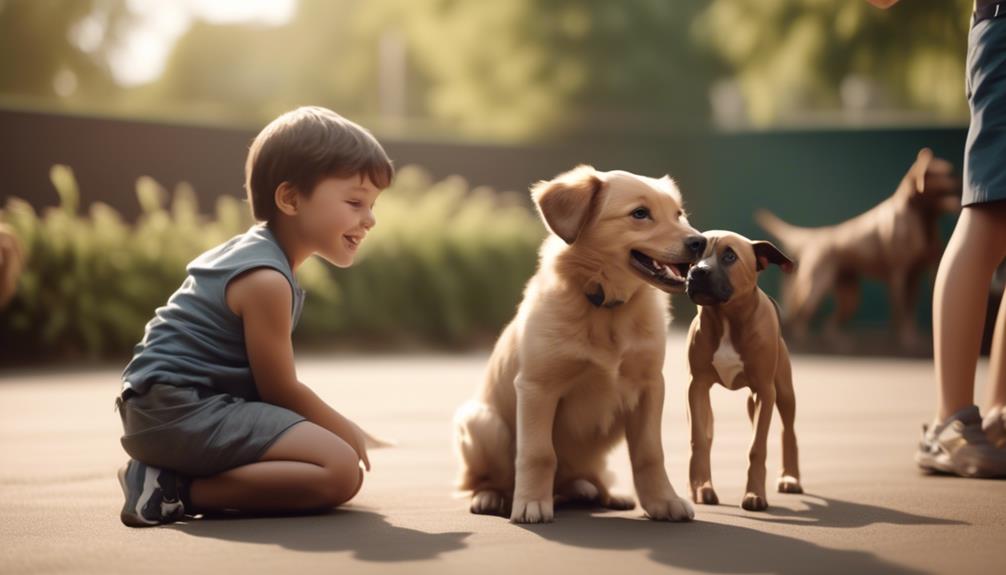How to Choose a Dog Breed If You Have Small Children

When it comes to choosing the right dog breed for small children, there are a few key factors to consider: size, temperament, and energy levels.
Size is an important consideration because you want a dog that is small enough to be safe around children, but also sturdy enough to handle some rough play. Small to medium-sized breeds are often a good choice, as they are generally more manageable for young children.
Temperament is another crucial factor. You want a breed that is known for being gentle, patient, and tolerant, as these traits are essential when it comes to interacting with small children. Breeds such as Labrador Retrievers, Golden Retrievers, and Beagles are often recommended for families with young children due to their friendly and patient nature.
Energy levels should also be taken into account. Some breeds are highly energetic and require a lot of exercise and mental stimulation. While this can be great for active families, it may be overwhelming for families with small children. On the other hand, some breeds are more laid-back and relaxed, making them a better fit for families with young children who may not be able to provide as much exercise.
In conclusion, when choosing a dog breed for small children, it is important to consider the size, temperament, and energy levels of the breed. By taking these factors into account, you can find a dog that will be a great companion and playmate for your children.
Key Takeaways
- Consider the size of the dog in relation to the child to ensure the child feels safe and is not overwhelmed or knocked over.
- Take into account the temperament and energy level of the breed, as some breeds may be more patient and tolerant with children while others may be overprotective or too exuberant.
- Training is important for a well-behaved dog around small children, so choose a breed that is intelligent and trainable.
- Consider allergies and shedding, as hypoallergenic breeds with minimal shedding may be more suitable for families with allergies. Regular grooming and maintenance are necessary for all dogs.
Size Considerations
When considering the size of a dog breed for small children, it's important to choose one that's suitable for their safety and comfort. Medium-sized dogs tend to be a good fit for young families with children. These dogs aren't too delicate like tiny breeds such as Maltese or Chihuahuas, which may not be able to handle rough play from energetic children. On the other hand, large dogs like Mastiffs can easily overpower small children, posing a potential risk. It's important for children to feel safe and not worry about being knocked over by a dog that's too big for them to handle.
Size also plays a role in the child's ability to interact with the dog. Toddlers, for example, may find larger dogs intimidating. Therefore, it's crucial to choose a breed that's small enough for the child to feel comfortable around.
Additionally, certain dog breeds are known for their high energy levels and need for exercise. It's important to consider this when selecting a breed for small children, as a dog with excessive energy may be difficult to manage.
Temperament and Energy Levels

Dogs with varying temperaments and energy levels are available for families with small children to choose from. When considering a dog breed for your family, it's important to take into account the temperament and energy level of the breed. Here are three key factors to consider:
- Temperament: Dogs from the Sporting Group, such as Golden Retrievers, Irish Setters, and Labrador Retrievers, have a patient and tolerant temperament, making them suitable for families with children. They're known for being friendly, gentle, and good with kids. On the other hand, Guardian breeds like Bulldogs and Bernese Mountain Dogs are excellent with their own children but may be overprotective around their friends, so supervision is necessary when they're around children. Herding dogs, like the Bernese Mountain Dog, may nip or overwhelm small children with their exuberance, so they require supervision when interacting with kids.
- Energy Level: Different breeds have different energy levels. High-energy dogs like Standard Poodles and Brussels Griffons may require ample exercise and attention to keep them happy and prevent them from becoming bored or restless. On the other hand, breeds like French Bulldogs and Bulldogs have lower energy levels and are generally more laid-back, making them suitable for families with small children who may not be able to provide a lot of exercise.
- Training: Some breeds are known to be easier to train than others. Golden Retrievers and Labrador Retrievers are known for their intelligence and trainability, while French Bulldogs may be a bit more stubborn. Consider the temperament and energy level of the breed along with their trainability when choosing a dog for your family with small children.
Allergies and Shedding

To minimize allergic reactions in families with small children, it is important to consider hypoallergenic dog breeds that have minimal shedding. These breeds produce fewer allergens, making them a better choice for families with allergies. Some examples of hypoallergenic breeds include Soft Coated Wheaten Terriers and Bichon Frises. When selecting a family dog, it is crucial to take into account the shedding tendencies of different breeds, as shedding can exacerbate allergies.
To help families make an informed decision, here is a table outlining the shedding levels and hypoallergenic properties of different breeds:
| Breed | Shedding Level | Hypoallergenic? |
|---|---|---|
| Soft Coated Wheaten Terrier | Minimal to Moderate | Yes |
| Bichon Frise | Minimal | Yes |
| Bulldogs | Moderate to Heavy | No |
For families with allergies, it is advisable to choose breeds that are hypoallergenic and have minimal shedding. These dogs will produce fewer allergens, reducing the risk of allergic reactions. It is also important to note that regular grooming and maintenance are necessary for all dogs, regardless of their shedding tendencies. By considering hypoallergenic breeds with minimal shedding, families can create a healthier and more comfortable environment for everyone in the household.
Trainability and Intelligence

Considering the trainability and intelligence of different dog breeds is crucial when selecting a family pet, especially for families with small children and specific needs such as allergies or shedding concerns. Here are three key factors to consider:
- Smartest dog breeds: Some dog breeds are known for their high intelligence, making them easier to train and interact with. Breeds like Border Collies, Poodles, and German Shepherds are considered among the smartest dog breeds. Their ability to quickly learn commands and tasks can make them excellent family dogs, as they can easily understand and adapt to the needs of small children.
- Easy to train: When choosing a dog breed for a family with small children, it's important to select a breed that's easy to train. Labrador Retrievers and Golden Retrievers are known for their trainability, making them popular choices for families. These breeds are eager to please and respond well to positive reinforcement methods, making training sessions more enjoyable and effective.
- Needs daily mental stimulation: Intelligent dog breeds often require daily mental stimulation to prevent boredom and destructive behavior. Engaging activities like puzzle toys, obedience training, and interactive play sessions can help keep these breeds mentally stimulated and happy. This is especially important for families with small children, as a mentally stimulated dog is more likely to be well-behaved around kids.
Exercise and Activity Requirements

When selecting a dog breed for a family with small children, it's important to consider the exercise and activity requirements of different breeds. Active dog breeds require regular exercise and activities to stay healthy and happy. It's crucial to choose a breed that matches your family's activity level and time commitment.
Some breeds may require more exercise and mental stimulation, so it's vital to factor this into your decision. By considering the exercise requirements of different dog breeds, you can ensure that your family and small children can meet the needs of the chosen breed.
Dogs that need high levels of exercise may thrive in families that enjoy outdoor activities such as hiking or running. On the other hand, if your family prefers a more relaxed lifestyle, a breed with lower exercise requirements may be a better fit.
Remember that keeping a dog physically and mentally stimulated is essential for their overall well-being and behavior. Therefore, choosing a dog breed with suitable exercise and activity requirements is crucial for a harmonious and happy family life.
Compatibility With Children's Ages

Taking into account the exercise and activity requirements of different breeds, it's now important to consider the compatibility of a dog breed with the ages of your children. Here are three key factors to consider when choosing a dog breed that's compatible with your children's ages:
- Size: Smaller dogs may be easily injured by young children, while larger dogs can handle rough play more effectively. It's important to choose a breed that's a good fit for your family and can safely interact with your children.
- Energy Level: Some dog breeds have high energy levels and require lots of exercise and mental stimulation. If you have active and energetic children, a dog with a similar energy level, such as a Jack Russell Terrier, may be a great fit. However, if your children are more laid-back, a calmer breed may be better suited to your family.
- Patience and Temperament: Dogs that are known for being patient and gentle, such as Labrador Retrievers and Golden Retrievers, are often considered great family dogs. These breeds are typically good with children of all ages and can handle the noise and activity that comes with spending time with kids.
Consulting With a Professional Veterinarian or Dog Trainer

Consulting with a professional veterinarian or dog trainer is crucial when choosing a dog breed that's suitable for your family and children. These professionals have the knowledge and expertise to guide you in making an informed decision. They can provide valuable insights into the temperaments of different dog breeds, helping you select breeds that are patient and tolerant towards small children. They can also advise you on breeds that may be overprotective or too exuberant for young kids.
In addition to temperament, professionals can offer guidance on grooming needs. Different breeds require varying levels of care, and understanding these requirements is essential when considering family-friendly options. Professionals can also provide insights into the energy levels and exercise needs of various breeds. This ensures that you choose a dog that fits well with your family's lifestyle and activity level.
When consulting with a professional, they can help you understand the specific needs of certain breeds. For example, larger breeds may require more space, and certain breeds may be prone to specific health issues. By considering these factors, you can make an informed decision that's best for your family and children.
Frequently Asked Questions
What Dog Is Best With Small Children?
Some small dog breeds, like Beagles or Bulldogs, can be great with small children. It's important to socialize dogs with children and teach kids how to interact properly. Supervision and training are key.
What Is the Most Gentle Dog With Kids?
Labrador Retrievers and Golden Retrievers are the most gentle dog breeds with kids. They have a friendly and patient nature, making them ideal for families with small children.
How Do You Know if a Dog Will Be Good With Kids?
Understanding a dog's body language is crucial in determining if they will be good with kids. Socialization and proper training are important, as well as evaluating a dog's temperament before bringing them into a home with children. Size and breed also play a role in compatibility.
What Is the #1 Best Family Dog?
The Labrador Retriever and Golden Retriever are the top family-friendly dog breeds. Their friendly and patient temperament, trainability, and compatibility with children make them ideal companions for households with small kids.









